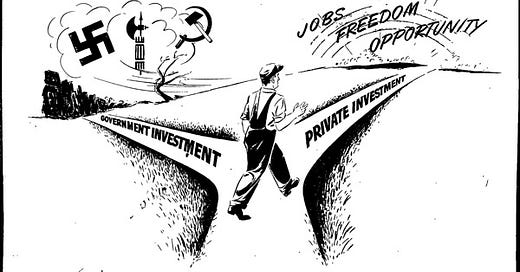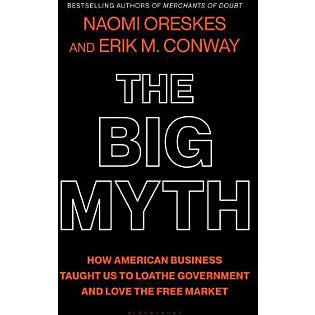The Counterattack of "the Big Myth"
Big Business Charges the 1919 Bishops with Promoting Socialism
In my previous post, I offered a detailed synopsis of the “1919 Bishops’ Program of Social Reconstruction” as an example of practical proposals that emerged from the participationist, reformist, and dialogical approach of social Catholicism. I showed how this document emerged from an ongoing solicitude for the great problems facing the human family, which results in a sober assessment of “the signs of the times,” and of the reforms proposed from various quarters to address them. We saw that this assessment explicitly eschewed extremes, such as the collective ownership of the means of production proposed by the socialists.
The Bishops’ Program provoked a stern response, however, primarily from those in the business community who sought to preserve not only a socio-economic system more aligned with laissez faire and social Darwinist ideology, but also the great wealth they received from it. The president of the National Association of Manufacturers (NAM) “complained to Cardinal Gibbons [of Baltimore] that the document was ‘partisan, pro-labor union socialist propaganda.’”1 Although the Bishops’ Program clearly supported workers and their labor unions, it rejected socialism and was not simply spewing propaganda but making carefully reasoned arguments. A similar response came from the editor of the “National Civic Federation Review, who said the bishops had been deceived by radicals whose programs ‘would overthrow our present institutions and inaugurate a reign of chaos.’”2
Msgr. John A. Ryan was certainly among the alleged “radicals” and “socialists” that these fear-mongering critics had in mind. Their criticisms had less to do with the fact that The Bishops’ Program was radical or socialist—which it certainly wasn’t—than that it threatened their high profit margins and political power. Since the start of the Russian or Bolshevik Revolution in March of 1917, moreover, accusations of “radical socialism” were tempting to make because they could easily tap into widespread fear, therefore packing great rhetorical force. Thus, they continue to be employed frequently to the present day on venues like Fox News. Although it is difficult to weigh the various factors that contributed by 1920 to the end of progressive era reforms, the concerted efforts of the National Association of Manufacturers were an increasingly significant factor in fostering the deregulatory climate of the “roaring twenties,” which led to the stock marked crash of 1929 and the subsequent Great Depression.
[Image Courtesy of Hagley Museum]
My main goal in this post is to introduce an excellent recent new work that documents the evolution of the extensive programs of persuasion—that is, propaganda—funded by business interests like NAM to shape public opinion against programs such as those advanced by the social Catholics, such as the 1919 Bishops’ Program. This new work is called The Big Myth: How American Business Taught Us to Loathe the Government and Love the Free Market, by Eric Conway and Naomi Oreskes.
The synopsis to The Big Myth is introduced with reference to an earlier bestseller by Oreskes and Conway, which should also be of great interest to social Catholics because it largely explains why Catholic Social Doctrine regarding responsible stewardship of our environment—or creation care—has been ineffective. Namely, because of a massive campaign of propaganda funded significantly by the petroleum industry. The Big Myth traces this propaganda campaign back to its beginnings, with considerable attention to the years immediately following the 1919 Bishop’s Program. The synopsis follows below.
The bestselling authors of Merchants of Doubt offer a profound, startling history of one of America's most tenacious--and destructive--false ideas: the myth of the "free market."
In their bestselling book Merchants of Doubt, Naomi Oreskes and Erik M. Conway revealed the origins of climate change denial. Now, they unfold the truth about another disastrous dogma: the “magic of the marketplace.”
In the early 20th century, business elites, trade associations, wealthy powerbrokers, and media allies set out to build a new American orthodoxy: down with “big government” and up with unfettered markets. With startling archival evidence, Oreskes and Conway document campaigns to rewrite textbooks, combat unions, and defend child labor. They detail the ploys that turned hardline economists Friedrich von Hayek and Milton Friedman into household names; recount the libertarian roots of the Little House on the Prairie books; and tune into the General Electric-sponsored TV show that beamed free-market doctrine to millions and launched Ronald Reagan's political career.
By the 1970s, this propaganda was succeeding. Free market ideology would define the next half-century across Republican and Democratic administrations, giving us a housing crisis, the opioid scourge, climate destruction, and a baleful response to the Covid-19 pandemic. Only by understanding this history can we imagine a future where markets will serve, not stifle, democracy.
Although The Big Myth doesn’t explicitly discuss the criticism of the 1919 Bishops’ Program by the National Association of Manufacturers and the National Civic Federation, the above synopsis mentions some of the key points of contention between them—namely labor unions and child labor—and helps situate the unfounded criticism of the Bishops’ Program within a much longer and spectacularly successful program of propaganda. From my long experience of teaching graduate courses on Catholic Social Doctrine (CSD), my impression is that the vast majority of American Catholics come to the topic having been deeply influenced by this campaign, which presents major obstacles to their reception of a vision much more conducive to the flourishing of individuals and of societies.
As I will continue to illustrate in future posts, the rationale for following a social vision consistent with the dignity of the human person and the solidarity of the human family—such as that provided by CSD—is compelling. I will argue, moreover, that it would clearly align Catholics with those seeking to preserve and renew our democracy. The problem, however, is that this message has not been effectively “propagated.” This failure can be attributed to several factors, including the lack of vision, the lack of institutional and financial support, and—especially where there are institutions and funding—debilitating distortions by partisan and ideological factors.
To overcome this failure and communicate an authentic Catholic social vision, potential or aspiring social Catholics need to become much more alert to “propaganda.” This must be understood both in the negative sense of messages that manipulate populations with lies and messages contrary to the common good, and in the positive sense of messages that foster justice, peace and human flourishing. I will revisit this topic in future posts. In the meantime, I refer readers to my short discussion of propaganda in section 6 of “Formation for a New Social Catholicism,” in Social Catholicism for the Twenty-First Century? Volume 1 Historical Perspectives and Constitutional Democracy in Peril.
Francis L. Broderick, Right Reverend New Dealer: John A. Ryan (New York: Macmillan, 1963), 106.
Broderick, Right Reverend New Dealer, 107. Although the National Civic Federation (NCF) purportedly functioned to bring together capital and labor, and made some contributions in this regard, it was founded by a staunch Republican and dominated by corporate interests. See, for example, the NCF entry on Wikipedia at link.






